Set in the misty mountains near one of Costa Rica’s most famous cloud forests is Café Monteverde. This generations-old coffee farm has developed over the years from a simple agricultural operation to a sustainability-focused and community-centered icon. In this post, we will share what we learned during our visit to Café Monteverde and how you can plan a visit too.
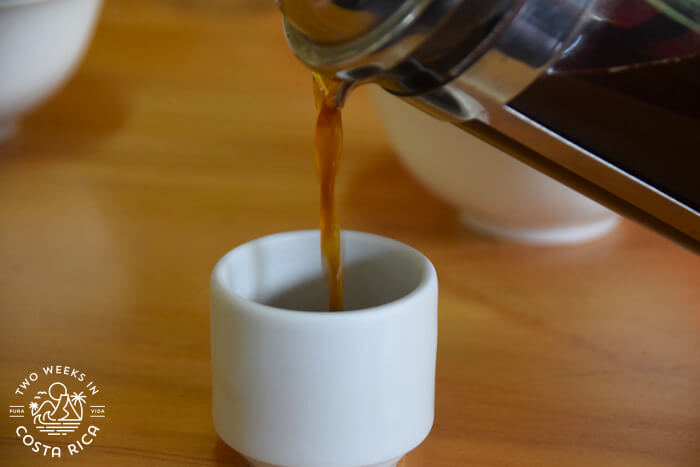
Location
Our tour started in the village of Canitas near Santa Elena on the outskirts of Costa Rica’s famous Monteverde Cloud Forest.
This area is about 2.5 hours from both of Costa Rica’s international airports. It is known for its cooler mountain climate and unique ecosystem.
After walking a path through some coffee plants, we reached the wooden building where our tour would begin. Here, in what is called the Monteverde Coffee Lab, we met our guide Jerson.
Cafe Monteverde Tour
Background
Driven by a passion for coffee and fueled by caffeine, Jerson was energetic and enthusiastic.
As our small group sat down in the room, we quickly learned that Jerson was a son of one of the original Café Monteverde founders.
In fact, his grandfather was one of the first to start growing coffee in the Monteverde area. He almost sold the farm, but Jerson’s dad and a friend saved it.
Today there are over 20 different owners, including uncles, brothers, sisters, and cousins.
Centered on Community
Jerson went on to explain that today, Café Monteverde includes much more than his own family circle. They work with other farms in the area too, encompassing 200 acres (81 hectares) in total.
Impressively, half of that land is kept in conservation to increase biodiversity and preserve the natural environment around them.

Together, the farms produce around 100,000 pounds (45,359 kg) of raw coffee beans per year. About 40% is exported while the remaining beans are used locally.
The community alliance doesn’t stop there. One dollar from every bag of coffee sold goes back to the community. Between the participating coffee farms and tours in Monteverde, around $60,000 per year is raised for projects and a backup emergency fund.
Walking the Property
After learning more about Café Monteverde’s history and values, Jerson led us outside to the fields.
Starting from Seed
Standing in front of a raised garden bed, Jerson told us that we were looking at the most important part of the coffee plant’s success, germination.
Hundreds of tiny seedlings, many still with coffee beans attached, sprouted from the rich black soil. Jerson explained that these seeds take a long time to sprout and it is important to give them the time they need.

In fact, good root development takes around two months! From there, the seedlings are moved into small soil bags where they will grow for another seven months. Finally, the sapling can be planted in the field.
It will take two more years before the plant can start producing coffee.
Bio Fertilizer
Our next stop was an open barn filled with dozens of plastic barrels, water tubes, and piles of rotting compost.
Jerson directed us to a corner where some displays were set up. We listened as he explained how Café Monteverde makes their own organic fertilizers. We could immediately tell that this was Jerson’s passion.
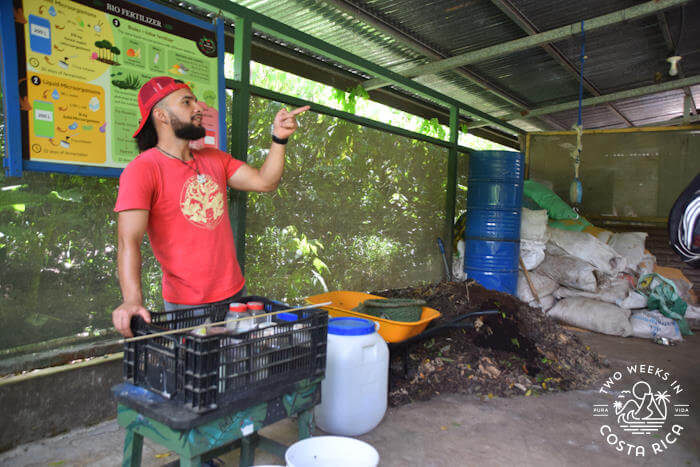
Passing around samples, we smelled jars, felt textures, and learned about all the different components that are integrated into their fertilizer recipes.
The description and processes were a bit complex, but here is what stood out. The base of the fertilizer comes from the forest. Tiny microorganisms growing in leaf litter on the forest floor naturally break down organic matter into nutrients.
To make the fertilizer, Café Monteverde borrows some of the forest’s leaf litter. They then combine it with other compost, water, and sugar. The mix is given time to brew, and finally, it becomes a concentrated liquid fertilizer.
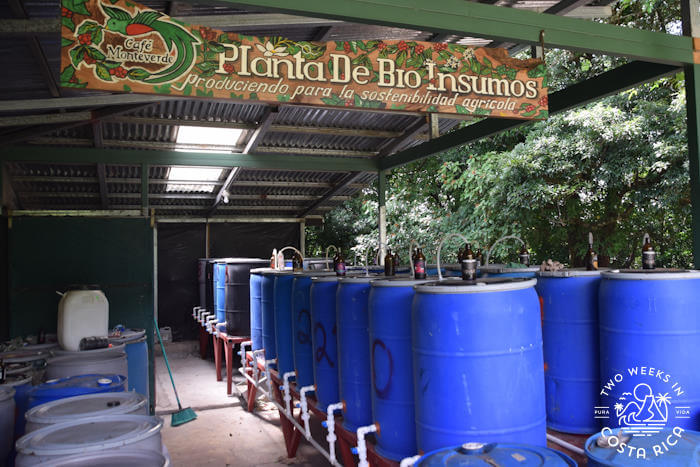
Jerson told us that it was his grandfather (some 90 years old) who first taught him about the beneficial microorganisms. He said, isn’t it funny that after all these years, we are going back to what we already knew?
Growing Sustainably
Back outside, Jerson walked through young coffee plants while explaining that 30 barrels of their biofertilizer supports up to 100 acres (40 hectares). They spray it around the plants and it soaks into the soil and roots.
The goal is to keep the plants as healthy as possible because they face a lot of challenges. Currently up to 20,000 plants on the farms die each year from disease. With climate change, things are getting worse.

Café Monteverde is also trying new varieties of coffee that are more resistant to disease. So far, they have 12 varieties. But each one takes years to grow, produce, and develop, so the trial period is long (around 10 years). For this reason, they keep 80% of the original coffee variety that was started back in the 1970s as their base.
A Mixed Crop
In the field, Jerson also pointed out different plants growing alongside the coffee. There were papaya, citrus, and banana plants.
We learned that banana plants serve as a wind break, soak up excess water, provide shade, and even have a natural bacterium that kills fungus.
Citrus trees, Jerson told us, are important because they flower at the same time as coffee, attracting more pollinators.
Natural Pest Control
Entering a greenhouse, we next learned about some of the other fruits and vegetables Café Monteverde grows. Things like lettuce, tomatoes, green beans, squash, etc. These are mostly used for the farm’s kitchen to help feed workers, students, and volunteers.
Jerson explained that they are testing some natural pest controls on their crops and coffee fields.
He went on to explain that certain plants can be added to the biofertilizer brew to make the spray not only fertilize, but also fend off fungi or predatory insects.
Looking at some kale that had been devoured by caterpillars, he joked that this is a work in progress.

Harvesting Coffee
While it wasn’t coffee picking season during our visit (July), Jerson didn’t let that stop him from explaining how it’s done. Jerson himself was a coffee picker for 16 seasons growing up.
While demonstrating how the coffee-picking basket is worn, we learned all about Costa Rica’s seasonal coffee pickers.
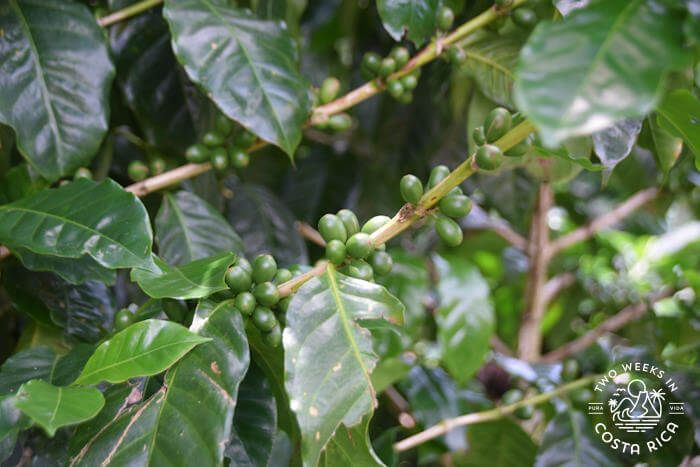
At Café Monteverde, almost all the pickers come from nearby Nicaragua. Some families have been coming back each picking season for over 20 years.
Jerson explained the importance of taking care of the pickers and their families. Their farm pays better wages and many of the pickers have moved up to work in higher positions at the farm.
They consider many of the pickers to be part of their family.
Roasting
Finally, it was time for a coffee break. Our group walked back inside and stood in front of a large roasting machine. They had finished roasting for the day, but we could still smell the rich aromas of toasted coffee in the air.
Jerson briefly explained about the roasting process and how each blend is made. Light, medium, and dark roasts are all heated at different temperatures for different amounts of time.
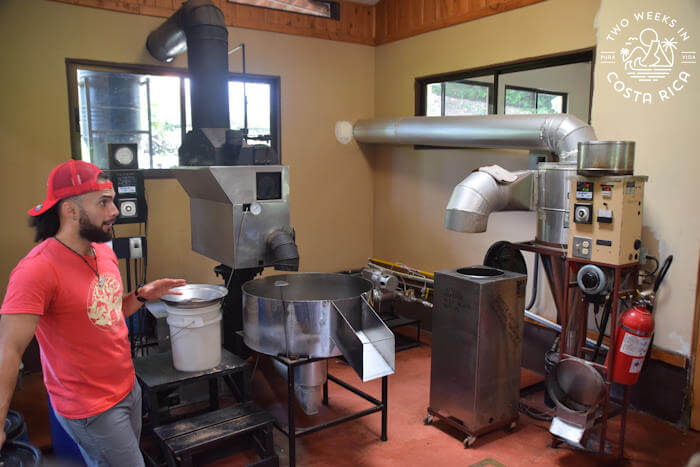
The process sounds easy but the coffee master, Roy, has been perfecting it for nearly 17 years.
To our surprise, there were more than just those three standard roasts. Jerson told us about three additional roasts they do at the farm. These were called honey, natural, and yellow berries.
Jerson explained some of the characteristics of each one.
Tasting
Moving back into the room where we started the tour, Jerson stood in front of six French presses. Each one, he told us, had the same amount of water and coffee. To be exact, 300 ml of hot water and 25 grams of coffee.
But they are all different, he said smiling.
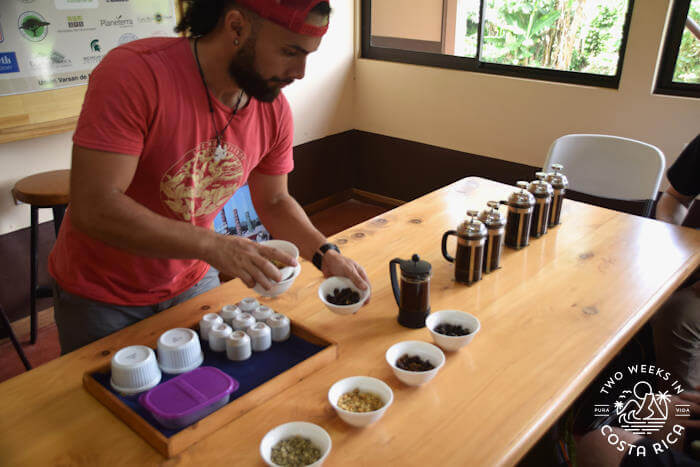
Passing around samples, he asked us to decide which roast was which. Everyone in our group could agree on which sample was dark, most agreed on which was light, but there was a lot of discussion about the other four.
It was a fun exercise and very tasty. Our overall favorite was the special limited batch that was called yellow berries. The origin of this coffee was from Brazil. It was mild, a touch sweet, and smooth to drink.
Conclusion
We waved goodbye to Jerson and thanked him for the awesome tour. It was a very educational experience and we learned so much from him in just a short time. We also got a great coffee buzz, which was important for our busy schedule that day!
If you have an interest in natural farming processes, sustainability, and/or community development, we’d highly recommend the Café Monteverde tour.
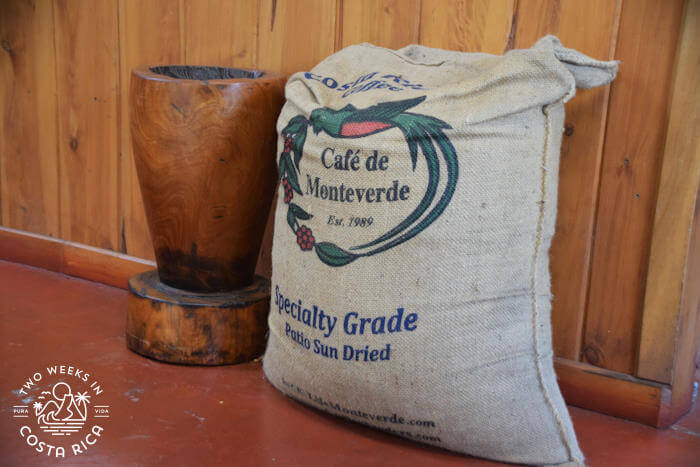
Planning Your Visit to Café Monteverde
Tour Times
Café Monteverde offers tours at 8:30 a.m., 9:30 a.m., or 2:00 p.m. with prior reservations.
Duration
About 2.5 hours
Cost
$40 per person adults
$12 per person children ages 6-12
Children 5 and under are free
*Transportation from nearby hotels is an additional $6 per person.
How to Book a Tour
Tours can be booked through the Café Monteverde website.
Have a question about visiting Café Monteverde or have something to add? Leave a comment below.
Looking for more Monteverde info? Check out these posts:
Selvatura Park: Cloud Forest Hanging Bridges Walk – This is one of our favorite hanging bridge walks in Costa Rica.
Monteverde Activities: Check out this list for more of our favorite tours in Monteverde that we book.
Monteverde Hotel Guide – Check out our handpicked list of lodges and hotels in Monteverde. Includes all price ranges.
Finca El Paraiso: A Sustainable Farm Tour in Monteverde – This dairy farm tour is an excellent way to experience the local culture and make some tasty treats!
